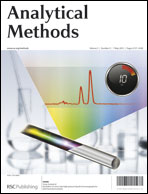Determination of essential and toxic metals in blood by ICP-MS with calibration in synthetic matrix
Abstract
A high throughput method has been developed and validated for the analysis of heavy metals in blood using inductively coupled plasma mass spectrometry (ICP-MS) with an integrated sample introduction system with discrete sampling (ISIS-DS). Blood analyses are performed using an Agilent 7700x ICP-MS in helium collision mode. For this study, we selected a metal panel that included As, Cd, Hg, Mn, Pb, and U. Blood specimens, reference material and intermediate calibration standards were diluted 50 times with a diluent composed of n-butanol, NH4OH, H4EDTA, Triton X-100 and five internal standards (ISTDs). A 50 times dilution alone however does not dissipate the blood matrix effect. We found that the addition of NaCl and CaCl2 to calibration standards created a synthetic matrix (SM) environment leading to excellent analytical accuracy for all metals in the study, with results for lead nearly identical to isotopic dilution technique results. In addition, our study demonstrated that under matrix-match conditions for blood samples and calibration standards, any ISTD can be selected for any analyte regardless of first ionization potential or atomic mass (i.e., 55Ge is an acceptable ISTD for 238U or 205Tl for 55Mn, etc.). This method was initially validated using the following external reference materials: four levels of NIST standard reference material (SRM) 955c samples supplied by the National Institute of Standards and Technology (NIST), Wisconsin State Laboratory of Hygiene (WSLH) blood sample pools that were used to prepare Filter Paper Blood Lead proficiency testing (PT) samples (June 2011 event), and multi-element blood samples supplied by the Institute National de Santé Publique Quebec (INSPQ). When calibration standards were prepared without the matrix-match components, notable differences between present study results and respective reference or mean values were observed. This approach may offer a universal technique to improve the accuracy of ICP-MS results for metal analyses in any complex matrix. This method is currently being used to analyze human blood specimens as part of the California Environmental Contaminant Biomonitoring Program (CECBP).


 Please wait while we load your content...
Please wait while we load your content...